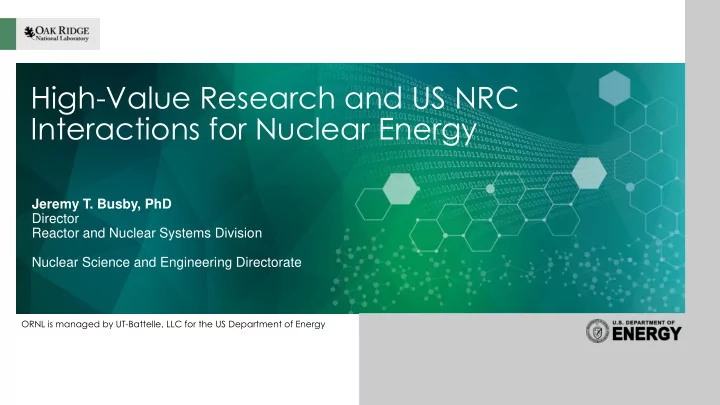

High-Value Research and US NRC Interactions for Nuclear Energy Jeremy T. Busby, PhD Director Reactor and Nuclear Systems Division Nuclear Science and Engineering Directorate ORNL is managed by UT-Battelle, LLC for the US Department of Energy
The national laboratories have a unique role in energy research in the United States • The national laboratories perform research for many national interests. – Basic and fundamental properties – New innovations and applied research • Combining basic to applied research can accelerate innovation and efficiently support deployment for nuclear energy. • Partnerships, collaborations, and support with the US NRC provides an avenue for cost- and time-effective research to make meaningful impacts. 2
Basic-to-applied research has the power to advance and accelerate reactor technology deployment Domestic loss-of-coolant accident VERA Core Simulator uses coupled New approaches shorten the test capability was re-established codes to accurately predict CRUD development and qualification cycle induced power shift and demonstrated New remote weld repair developed Chloride salt purification system was TRIstructural-ISOtropic (TRISO) conceived, built, approved for use, to remediate nation’s aging spent fuel pebbles and operated in a 3-month period nuclear fuel canisters Accident- tolerant fuel (ATF) FeCrAl cladding 3
Industry is actively pursuing advanced reactor concepts (including molten- salt reactors (MSR’s)) Intrinsically safe designs, lower Retain or increase electricity Achieve greenhouse costs, high burnup, minimal baseload in lieu of retiring gas reductions waste light water reactor fleet and clean air goals Liquid fluoride Thorium Integral Liquid fluoride thermal molten salt cooled reactor thermal thermal reactor reactor (FHR) salt-fueled fast reactors • Interactions between US NRC, developers, and customers are developing a common understanding and expectations (e.g. gap analysis report and phenomena-identification and ranking table (PIRT) processes). • New capabilities help developers successfully develop and license MSRs (e.g. design and licensing workshops). • Developing MSR specific design criteria though ANS 20.2 and other key regulatory bodies supports future deployment. 4
National laboratories are partnering with NRC to extend codes, data, validation, and methodologies to enable reviews of accident tolerant fuels and non-LWRs MELCOR Severe Accident Analysis Nuclear Reactor Sensitivity/ data physics uncertainty 1.015& 6.1& 238& 6.1& CE& 1.010& 6.2& 238& 6.2& 252& 6.2& CE& 1.005& 1-exp& unc& 1-xs& unc& 1.000& 0.995& 0.990& 0.985& MACCS Criticality Radiation Interfaces/ Verification/ safety shielding Training Offsite Consequence validation Analysis • Experimental coupling and validation are essential to any tool development. • Combined, these validated codes provide tools for understanding, mitigating, and preventing accident scenarios. 5
National laboratories are now pushing low-TRL level technologies to deployment through industry support ORNL developed and GE- IRONCLAD • Hitachi deployed ATF Partnership cladding technology based on FeCrAl alloy Increased accident • tolerance without sacrificing normal operation First non-Zr based fuel clad • inserted into a LWR in decades Data is compiled in • materials handbook Provides unique training • and collaboration opportunity with US NRC Staff 6 6
New ”mini - fuel” experiments may provide insights into high-burn up performance 0.10 0.08 Pressure (psia) 0.06 The new testing capability • 0.04 simplifies experiment design 0.02 and analysis — accelerating 0.00 fuel qualification and 0 20 40 60 80 100 120 140 enabling understanding of Time (sec) basic nuclear fuel behavior. Pressure rise during puncturing Approach minimizes • variables and experimental uncertainty, leading to Centering thimbles higher quality data. Passive SiC thermometry First tests focused on fission • Sealed capsule gas release and swelling of Mo filler uranium nitride fuel for light water reactors — a fuel lacking any current performance data. In-cell puncturing apparatus for measuring fission gas release of first MiniFuel capsule Cup UN kernels 7 7
Advanced tools have the potential to accelerate future innovations in nuclear • Modern tools in other fields have greatly expanded the “state of the art.” – Advanced manufacturing – Artificial intelligence – Advanced sensors and controls • These tools may dramatically reduce deployment costs and timelines of nuclear energy systems while maintaining safety and simplifying operations. • Collaboration with the US NRC is an opportunity to identify gaps in adoption of these new methodologies. – Code qualification/standards – Big data needs – Licensing 8
• Science and technology research at the national laboratories is driving new innovation in nuclear energy as new tools become available in other fields. – Advanced reactor designs – Accident tolerant fuels – Many other areas • State of the art tools may further improve safety, efficiency, and economy of nuclear power. • Engaging with the US NRC is welcome and mutually beneficial. 9
Recommend
More recommend